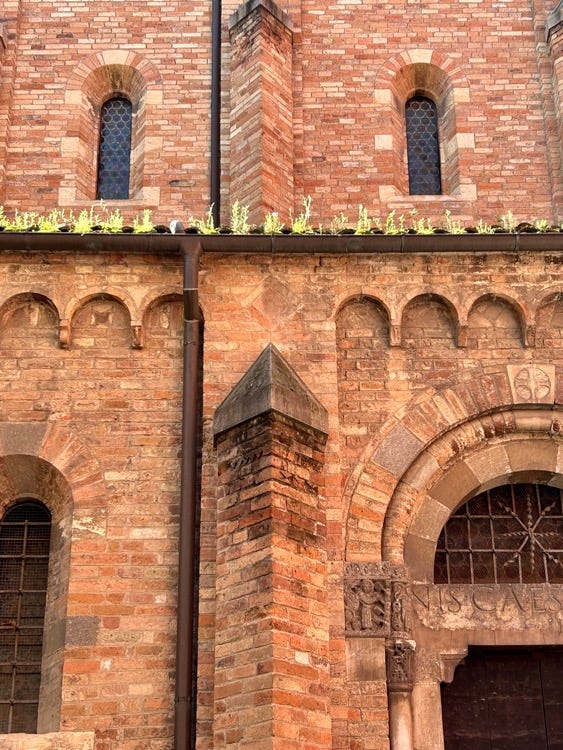
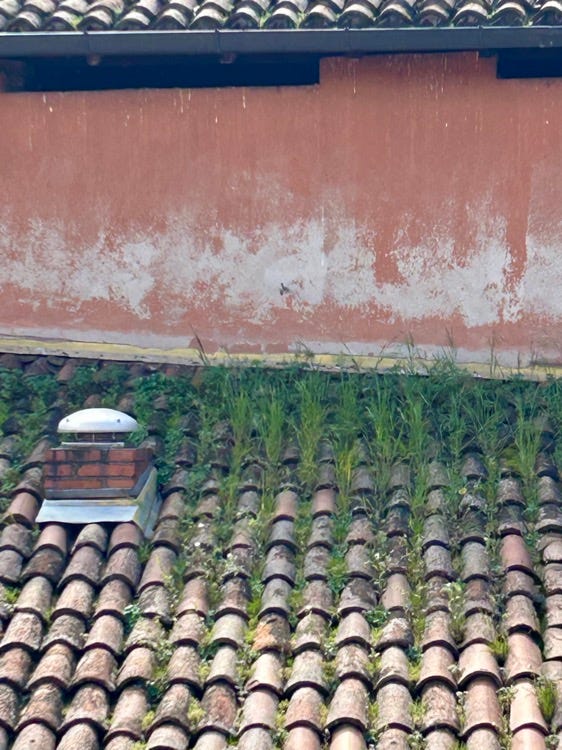
Grass grows on the city’s rooftops, creating a lawn where you wouldn’t expect to see tufts of grass shining in the sun.
From my home studio window, I observe a small patch of green on that of the building in front of me, a former monastery, while the old bell tower watches over me in turn.
Those thin green blades look like wheat. Or maybe it's just me, as it always happens this time of year, feeling the call of the countryside.
Even though I was born and raised in a small town and have been living in Bologna for over two decades, as a child, I had the chance to experience the countryside before modernity erased every trace of the past.
I am a pragmatic person; things happen. However, although I accept changes without difficulty, spring is an uncomfortable dress.
The bright, almost overwhelming colors of life coming back to life bring to mind memories of people, scents, lights, animals and produce. The old house's yard was the center of an agricultural world where I learned the difference between the flavors of the unripe and ripe vegetables, picking them directly from the plants; I gathered nettles and other herbs, cleaned the rabbit hutch and chicken coop, and collected the eggs. With the eyes of memory, I see an endless expanse of green grass fields that, under a roof of air and light, would soon become wheat.
And without harvest, how would we have made bread?
Food and rituals
In the past, more than today, the consumption of certain foods was linked to the milestones of human life and the year and held a ritual value. Regarding the life cycle, banquets were associated with sacraments, especially marriage, but not only. In Romagna, it was a habit to organize a lunch after childbirth, during which, traditionally, people used to eat tardura, a soup whose flavor resembles that of passatelli (soon the recipe).
Tardura is also a typical dish in Roman, Marchigiana, and Abruzzese cuisines, where it is known as stracciatella. In Romagna, it is also referred to as minestra del Paradiso (Heaven Soup).
One ritual lunch that has been forgotten is the funeral meal, which was common in the 19th century. The menu changed depending on the social status of the deceased's family; however, chickpeas or manfrigoli (a typical fresh pasta from Romagna) were always included because they resemble seeds in shape and size, symbolically evoking the possibility of the resurrection, just as buried seeds give life to plants, as Eraldo Bandini, an Italian writer, told (2003).
Furthermore, the table exalted the seasons. I think about, for instance, the tortelli di erbette (herb and ricotta tortelli), typical of Parma and Piacenza, which celebrate the beginning of summer on the occasion of San Giovanni.
Naturally, the main religious holidays of Christmas and Easter offered many ritual dishes. In Emilia-Romagna, along the Via Emilia, the quintessential Christmas first course was and still is a minestra (pasta in broth).
The Carnival rituals, characterized by indulgence and feasting, were followed by those of Lent. There was/is no Easter without Lent. The Lenten rules weighed heavily on those who lived in a perpetual Lent due to poverty. Their usual diet was typically based on stale bread and, depending on the regions of Italy, rice, grains, or polenta. The wait for Easter felt endless for those who did not have the chance to add something to flavor a bread soup.
The Lent of Bread
My grandmothers would never have sat down at a table without bread. Moreover, both used stale bread for various preparations: breadcrumbs, passatelli, soups, bread balls, savory pies and sweet cake.
Bread, and food in general, was precious, and waste was not admitted in a predominantly agricultural society like Italy until the 1950s, regardless of social class. Of course, as you moved from the top to the bottom of the society, bread became increasingly important since it was the primary food for poor people.
Bread soup is a humble dish from the peasant tradition, widespread throughout Italy, prepared with local ingredients and following local customs. The regional variations of bread soup tell the same story: where there was little to eat, stale bread was essential.
It was, therefore, the dish for the longest and most challenging days of winter when the land yielded nothing; and also for summer when, thanks to herbs and vegetables, it took on different forms, and the bread, instead of going into the soup, was just soaked (panzanella) or dressed (bruschetta); not even to say, it was the leading food during Lent.
In Emilia-Romagna, bread soup is called pancotto. It used to be the food of the poorest people. Pancotto is the more poor version of bread soup since the bread cooks in water rather than broth, unlike other soups such as the panata (Romagna area) or panada (Emilia area).
It was a dish more suited to filling than nourishing. Especially when the bread was made with low-quality flour, the only kind the poor could afford, even those in the countryside.
Nineteenth-century diaries of numerous travelers tell that people forced to eat pancotto, made only of water and low-quality gray bread, had "sad, pale, and expressionless" faces.
You can easily understand that it was a feast whenever it was possible to add a bone, a piece of lard, or the boiling water of cotechini, which have always been made in Romagna and not just in Emilia.
Lent extinguished any aspirations, and those 40 days of bread soup must have been unbearable. For us today, ribollita, perhaps the most famous Italian bread soup, is a gourmet dish. At the same time, less than a century ago, it was the food of those who had no alternatives.
In Romagna, on Holy Saturday, it was tradition to break e' pignat, the earthenware pot used to cook the pancotto, to announce the end of Lent.
A late 19th-century account tells of a maestro (teacher) from a mountain village in the Forlì province who marched with the pot to the main square, where he threw it to the ground, accompanying the gesture with a litany of words unbefitting his role. This liberating gesture makes clear how difficult living on bread and water was.
Bread soups
There are many versions of this dish, and once used to be many more.
The knowledge of women from the past made a difference in its preparation. The use of garlic, herbs, flowers, tomatoes, potatoes, beans, celery, onion, and lard allowed for flavoring and characterizing the dish concerning economic availability, seasonality, and local traditions.
Pancotto, a dark bread soup from Trentino-Alto-Adige, Gallurese soup (Sardinia), pappa al pomodoro and ribollita (Tuscany), Canavese soup (Pidmont), and Pavese soup (Lombardia) -to name a few- are sister recipes of Italian regional cuisine. This tradition also includes bread gnocchi and canederli (again, Trentino).
Acquacotta (cooked water) was a soup typical in the Apennine area of the upper Savio Valley (Romagna). The Savio Valley stretches from the slopes of Mount Fumaiolo, where the Savio River, as well as the Marecchia and the source of the Tiber (yes, the famous Roman river origins in Romagna!), originate, all the way to the Adriatic Sea coast. The recipe called for a soffritto of lard and onion or, in summer, shallots. To this initial mixture, bread and water were added first, followed by fresh tomatoes (or tomato puree) and sometimes beans. After cooking, raw vegetables like spinach, celery, and Swiss chard were added. A sprinkle of cheese was never missing in the bowls or, to economize, in the soup pot.
As I write, I also think of Carlo's words, the owner of the Delfina restaurant in Artimino, a hamlet of the municipality of Carmignano (province of Prato), a guardian of authentic Tuscan culture, as he recalled the gesture of his grandmother Delfina, who at his wedding banquet gathered the crumbs from the table to set aside for making ribollita. If you find yourself in that area, stop by for a meal; it's definitely worth it!
Bread salad
Panzanella also belongs to the family of recipes from cucina povera based on stale bread. It is a rustic dish: bread soaked in cold water and mixed with onion, tomatoes, and anchovies and seasoned with oil, vinegar, salt, and aromatic herbs.
This dish is typical of central Italy, but it is practiced in Romagna due to its geographical proximity, as noted by the gastronome Graziano Pozzetto (2009). Panzanella originated in other regions and spread to nearby places like Romagna, the last part of northern Italy where Pianura Padana ends.
In the countryside around Ravenna, bread was enriched with onion and seasoned with oil, salt, and pepper. The use of oil does not necessarily imply olive oil. Although Romagna is historically a producer of extra virgin olive oil, its spread was long limited by cost, and its introduction into cooking is relatively recent. In the Valmarecchia area, near Rimini and bordering the Marche region, panzanella was prepared with oil, salt, vinegar, garlic, parsley, or raw wild herbs.
If you enjoyed my newsletter, please click on the ❤️ heart, leave a comment, or share it. GRAZIE!
Bread pastasciutta
While researching for this newsletter, I read about a bread soup of Romagna known as pastasciutta di pane, which reminded me of the pappa al pomodoro and ribollita that Delfina used to make. According to Carlo, the grandchild, that dish tasted of herbs and flowers and had a thick consistency (it was not very brothy).
The bread pastasciutta requires to sauté celery and onion, add stale bread, water, and a pinch of salt. During cooking, tomato sauce (or fresh tomatoes) are added to the pot. The last thing to do, at the end of cooking, is a sprinkle of grated cheese.
I also added a drizzle of olive oil and a few basil leaves. And, like Delfina's ribollita, it has a thick consistency and you need a fork for eating it.
I rarely see my husband to enjoy three quite full dishes of the same food. I didn't expect that success, but I must admit, I found it delicious beyond my expectations. With leftovers, I made a bread savory cake. I spread the leftovers in a baking dish, leveled it with a spoon, and baked it until the edges were crispy.
If you top it with a fresh salad already dressed, you'll have an exceptional one dish.
Bread pastasciutta recipe
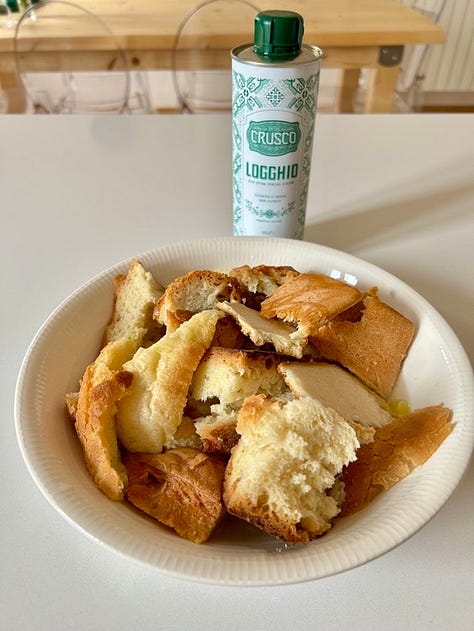
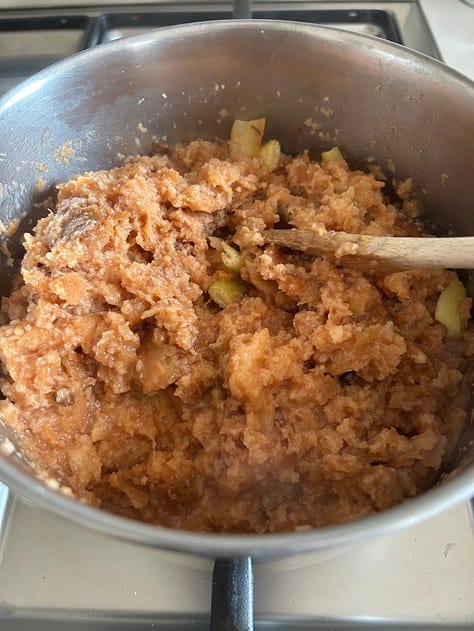
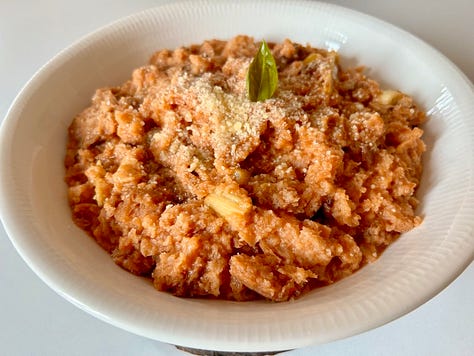
serves 4
Ingredients
200 g stale bread
700 ml water
100 g celery
50 g shallot or onion
1 g coarse salt
100 g tomato sauce
20 g tomato paste
30 g grated Parmigiano or other vegan equivalent
olive oil and salt to taste
a few basil leaves, washed and dried
Method
Cut the bread into pieces, place it in a bowl, and cover with half of the water. Let it rest for 10 minutes.
Meanwhile, finely chop the shallot (or onion) and cut the celery into pieces about 1 cm long.
Place the vegetables in a large pot with olive oil, a pinch of salt, and sauté gently for 5 minutes.
Then add the bread with the water and put the pot on a small burner over medium-low heat.
Add the coarse salt and the rest of the water. Stir, add the tomato sauce and paste, stir again, and cook for 10-15 minutes or until the mixture is almost dry. It should not be liquid, just soft.
Add the Parmigiano, a generous drizzle of oil, and fresh basil, stir, and taste. Adjust the salt if needed.
As first course, serve the bread pastasciutta warm; if it is a side, serve it at room temperature with a tray of vegetables.
Tips
You can use half water and half broth (whatever you prefer).
You can add other flavors to your liking: a sprinkle of fresh or dried oregano, a few tablespoons of finely chopped capers, or a handful of pitted olives.
Savory stale bread cake

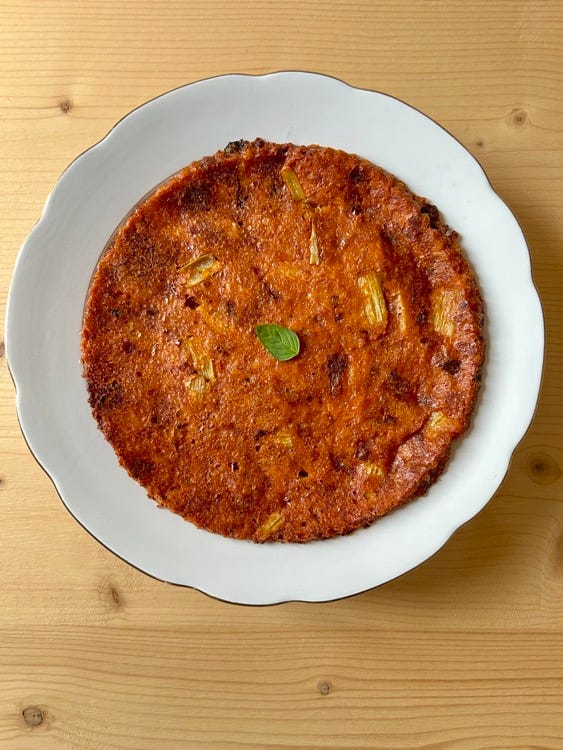
4 serves
Ingredients
Those from the previous recipe reduced of 50% or leftovers.
Method
Preheat oven to 190C (374F) degrees.
Grease a baking pan about 18-20 cm in diameter. Add the seasoned bread, spreading it into a thin layer.
Place the pan in the oven and bake for 12 minutes or until the edges become crispy.
Let’s keep the conversation going.
Write to me at tortellinico@gmail or follow me on Instagram.

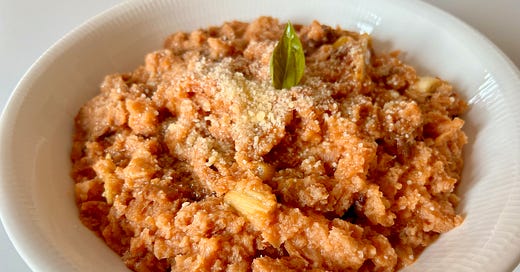



Cooked water made me laugh and then reminded me of stone soup. Stale bread is handy in so many ways. I like the toasted crumbs substituting for cheese sprinkles.
Thank you for this beautiful story. I hope the wise lesson that we have to be “careful” and “thankful for our bread will be wide